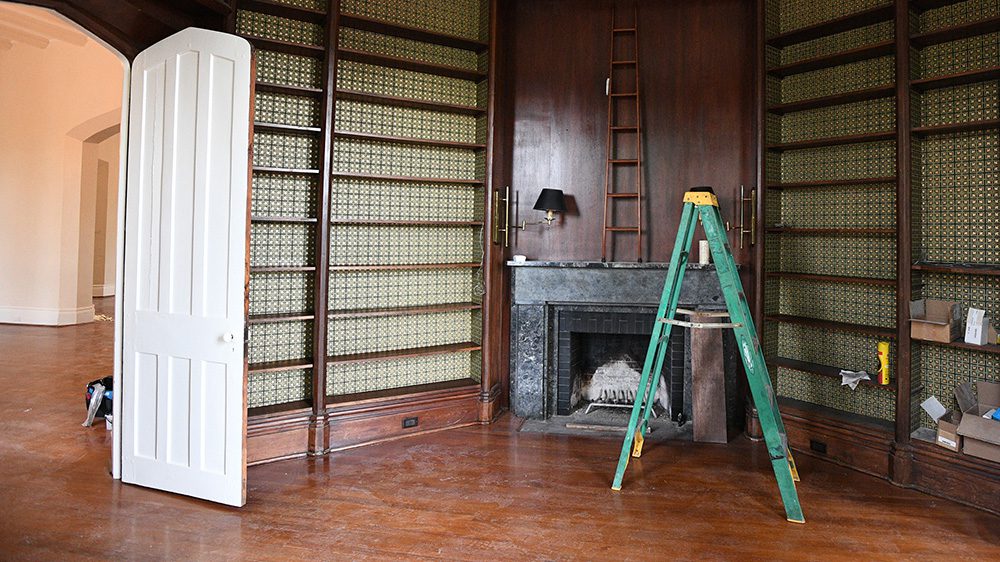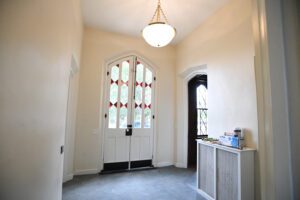VMI Superintendent’s Quarters Renovated

The library and its book casing received attention in the renovation of the Superintendent’s Quarters.—VMI Photo by Kelly Nye.

The library and its book casing received attention in the renovation of the Superintendent’s Quarters.—VMI Photo by Kelly Nye.
One of the oldest buildings on the VMI post, the Superintendent’s Quarters is a crown jewel of Gothic Revival architecture designed by 19th-century American architect Alexander Jackson Davis, who also designed the barracks. With its copper roof, twin turrets, and prominent location by the Parade Ground, the house immediately attracts the attention of visitors.
The house was completed in 1862 but was moved in 1914 from its original location (what is now the center of the Parade Ground) when the Parade Ground was enlarged from 5 to 12 acres. Two other houses were moved at the same time, including the current commandant’s house.
Beginning in 2021, the Superintendent’s Quarters underwent a $2.4 million renovation project that took nearly a year to complete, in addition to a full year of planning and design. Before this renovation, the last significant work on the house was completed in the early 1990s.
Since the home is part of the VMI historic district and is on the National Register of Historic Places, renovation consultants included architectural historians at the Commonwealth’s Department of Historic Resources. When Maj. Gen. Cedric T. Wins ’85, superintendent, moves in this summer, the structure will have served as a home to all 15 of VMI’s superintendents.
Many U.S. presidents and foreign heads of state, as well as U.S. and foreign military leaders, have visited the house. Like the White House and the Governor’s Mansion, the Superintendent’s Quarters was built for both public and private use.

The Superintendent’s Quarters is now ADA compliant with a new accessible entryway.—VMI Photo by Kelly Nye.
According to Col. Keith Gibson ’77, VMI Museum System director, President Franklin D. Roosevelt was scheduled to address the Corps of Cadets in person Nov. 11, 1939, the centennial anniversary of VMI. “Special alterations were made to the house for the president, who had been a victim of polio,” said Gibson. “A special entrance to accommodate his wheelchair and a first-floor bedroom with adjoining bathroom were quickly constructed. But when Hitler invaded Poland on Sept. 1 of that year, the president had to cancel his VMI visit. Instead, loudspeakers were placed on the Parade Ground and the president addressed the Corps as they stood in parade formation via a long-distance phone call from the Oval Office,” said Gibson.
Lt. Col. Daren Payne ’90, deputy director of construction, said it had been at least 25 years since any significant renovations were done to the quarters. “This yearlong project enabled us to upgrade and modernize the building with more reliable and energy-efficient systems, make the building handicap accessible, update interior finishes and furnishings, while also providing fresh landscaping, and fixing the roof and some exterior features. Seeing such a historic building undergo a renovation and come back to life, looking fresh and modern while retaining its historic character, is a rare opportunity,” said Payne.
The project included a new HVAC system, new sewer and water lines, a new electrical system, new copper roof, gutters and downspouts, plaster work, fresh paint, new bathroom fixtures, updated landscaping, and new furniture. A ramp was built from the sidewalk to the side door making the home accessible to all. A first-floor bathroom was retrofitted to comply with current ADA requirements.
A modern feature to the house is fiber optic access to the internet. Wins is the first superintendent to be able to access the VMI network from his living quarters.
The first floor, used mainly for entertaining and special events, consists of an entry hall, dining room, sunroom, kitchen, breakfast room, butler’s pantry, drawing room, game room, library, governor’s suite, and den. There is a full basement, but it is only partially finished. A caterer’s kitchen to be used for large special events is in the basement. The second and third floors are private quarters for the superintendent and family.